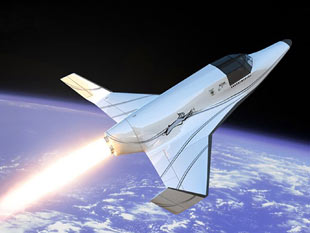Plans to develop a rocket-powered spaceplane that can put passengers into microgravity - within a half hour - gained a fillip from funding deal signed in September
Having cleared a critical cash hurdle, suborbital spaceflight aspirant Xcor is pressing ahead with spaceplane development in its bid to carry fare-paying passengers to the edge of space.
Xcor's rocket-powered Lynx spaceplane is a runway takeoff and landing concept designed to carry a pilot and one passenger to 103km and microgravity at speeds up to Mach 2.9 before a 4.5g pullout and gliding descent. The entire flight will take 30min.
The Mojave-based operation unveiled its Lynx concept in 2008 and had hoped to have wheels up for a test flight in 2010, but despite a 2009 wet lease agreement with Yecheon Astro Space Centre in South Korea, funding remained a sticking point owing to political tension on the Korean peninsula and the financial crisis.
However, a similar 2010 agreement to provide tourism and scientific flights from Curacao has been firmed up, with Space Expedition Curacao in September 2011 completing in a "multimillion dollar" transaction as part of an eight-figure deal that has Xcor funded through its development phase.
 |
|---|
| Lynx Mk 1 Copyright: RexFeatures |
The company has been hiring people - taking its head count above 30 - and has begun parallel development of most systems required to make Lynx a reality, says Xcor's Mike Massee.
Now, says Massee, Lynx is nearing the end of wind-tunnel testing, the fuselage shape is being firmed up and wings are near to a final form for the Mk1 version of the craft, which will be used for flight testing from late 2012. Development of systems including electronics, tanks and landing gear are "flowing in parallel", he says, adding that engines are "very far along" and one critical component - a piston-based pump for cryogenic fuels - is in "active" development with technology partner United Launch Alliance.
Xcor's goal, says Massee, is to bring together the fuselage and engines for testing as a single unit. The various parts of the project, he says, are "moving as fast as we can make them move. It's like a thousand little pieces, and it doesn't look like much until they're all there."
If Lynx Mk1 flies as planned next year, Xcor hopes to have the MkII commercial version ready for revenue service in 2014 or 2015.
In addition to Curacao and South Korea, Xcor has sold at least six Lynx suborbital flights to the independent, non-profit Southwest Research Institute of San Antonio, Texas, which has also bought two flights aboard Virgin Galactic's suborbital SpaceShipTwo, also being developed in Mojave, and will use the flights to carry scientists and experiments beyond the atmosphere.
Xcor has also signed with the Planetary Science Institute to fly an observatory aboard Lynx, to examine objects close to the sun. The payload will be controlled by an operator inside Lynx.
The 9m (30ft)-long Lynx promises 2h turnaround from a normal runway and up to four flights a day, with 40 flights between preventative maintenance operations. In addition to the pilot and passenger, the craft is designed to carry payloads of up to 650kg (1,430lb) in either the pressurised cabin or exposed to the vacuum of space or thin air of the upper atmosphere, with a maximum altitude of 330,000ft.
Massee says Xcor is hopeful that it could again enjoy the "smooth" development path it previously experience with its rocket-powered aircraft intended for racing, organised by the X Prize Foundation. However, he notes that there is far more complexity in Lynx, notably its supersonic performance and pressurised cabin.
And, stresses Massee, Xcor's core capability is in rocket motors; the airframe is a secondary capability.
One area where the Lynx programme would appear to have no doubts about capability is in piloting. Ideally, a Lynx pilot has experience in fighters and gliders, and chief test pilot Rick Searfoss of Xcor has both. A retired US Air Force Colonel, Searfoss has piloted two Space Shuttle missions and commanded a third.
Source: Flight International


























